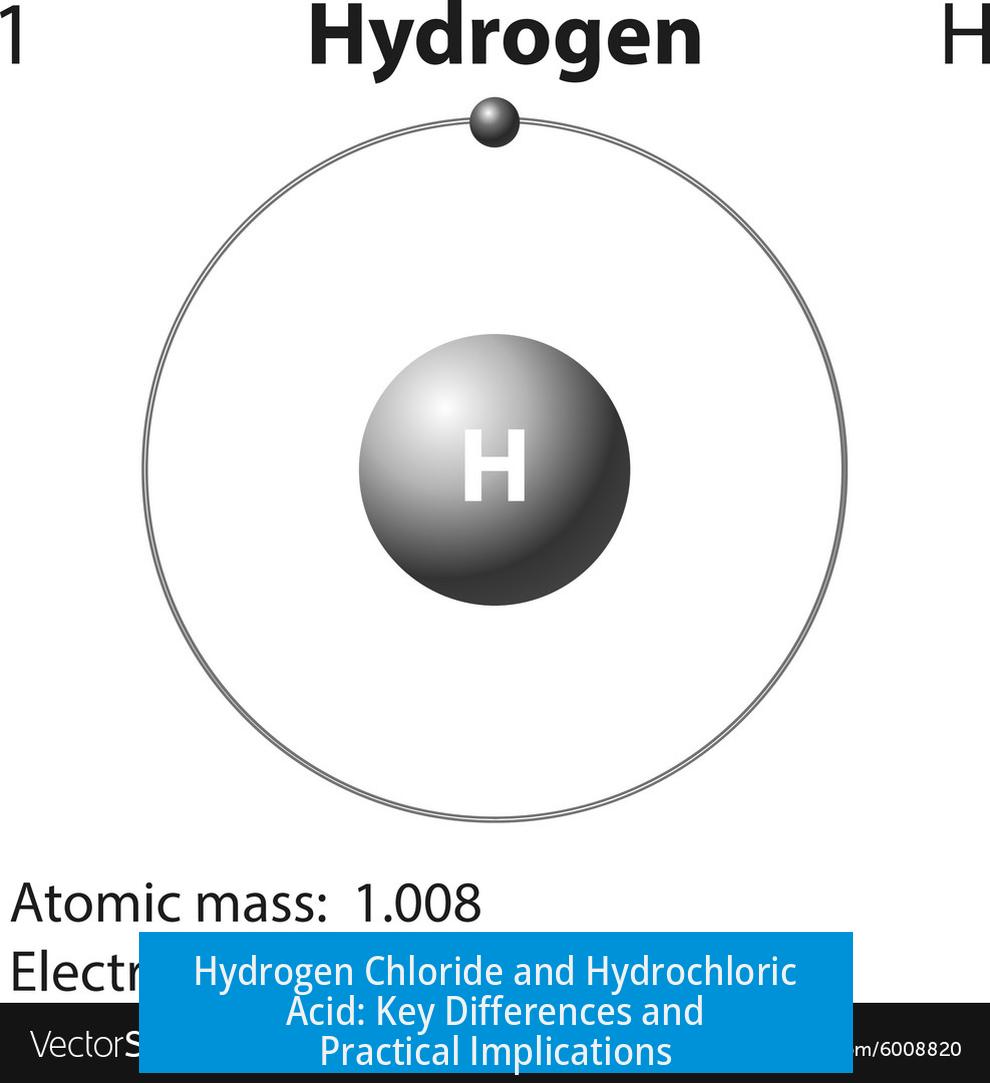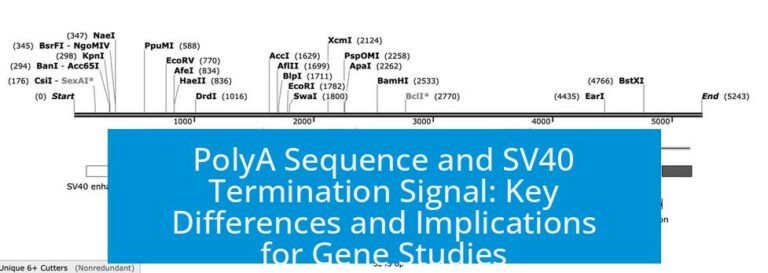Hydrogen Chloride vs. Hydrochloric Acid
Hydrogen chloride is a covalent gas composed of molecules of HCl, whereas hydrochloric acid is an aqueous solution of hydrogen chloride gas dissolved in water, resulting in complete ionization into hydronium (H3O+) and chloride (Cl-) ions, creating an acidic medium.
1. Definitions and Physical States
1.1 Hydrogen Chloride (HCl)
Hydrogen chloride exists as a gas at room temperature. With a boiling point near -85°C, it is gaseous under standard conditions. The molecular formula is HCl, and it forms by burning hydrogen gas in a chlorine atmosphere. This reaction produces colorless gas known as hydrogen chloride.
This gas lacks free ions and remains as discrete molecules. Its gaseous state distinguishes it physically from hydrochloric acid. It does not contain water or dissociated ions in this form.
1.2 Hydrochloric Acid
Hydrochloric acid results when hydrogen chloride gas dissolves in water, producing an aqueous solution. Typically, commercial hydrochloric acid is about 35% weight/weight concentration of HCl in water. It forms industrially by directing hydrogen chloride gas through water via a countercurrent flow system.
The resulting liquid is a clear, colorless solution that behaves entirely differently from the gaseous HCl. Its defining feature is the presence of free ions derived from dissolved hydrogen chloride molecules.
2. Chemical Nature and Bonding
2.1 Nature of Hydrogen Chloride Bonding
In its pure gaseous state, hydrogen chloride comprises covalently bonded molecules. The bond between hydrogen and chlorine involves sharing of one electron pair. Chlorine has a high electronegativity, creating a polar covalent bond by pulling electron density toward itself.
Despite polarity, the bond remains molecular with no ion formation upon vaporization. It is neither an ionic compound nor composed of separated ions. The electrical attraction between H+ and Cl- ions is not overcome in the gas phase at room temperature, preventing dissociation.
2.2 Hydrochloric Acid Bonding and Ionization
When hydrogen chloride dissolves in water, it undergoes a chemical reaction rather than simple physical dispersion. The polar HCl molecule reacts with water molecules to produce hydronium ions (H3O+) and chloride ions (Cl-).
This process is effectively ionization, although not a classical dissociation as seen in ionic compounds. Instead, the proton from HCl transfers directly to a water molecule forming the hydronium ion while the chloride ion acts as a spectator ion.
The interaction creates a highly acidic solution, characterized by a high concentration of free protons in the form of hydronium ions. This ionic environment defines hydrochloric acid’s strong acidity and chemical reactivity in solution.
3. Dissolution and Ionization Processes
3.1 Dissolving vs. Ionization
Dissolving is the process of mixing a solute with a solvent to form a solution. It does not necessarily require the solute to dissociate into ions. Gases commonly dissolve in water, such as oxygen and carbon dioxide, without ionization.
Hydrogen chloride gas dissolves in water by mixing, but unlike non-reactive gases, it also ionizes extensively. This ionization distinguishes hydrochloric acid from mere gas dissolution.
3.2 Ionization Mechanism of HCl in Water
Upon entering water, a hydrogen chloride molecule transfers its proton to a water molecule forming hydronium (H3O+) and leaving a chloride ion (Cl-). This reaction is represented as:
HCl + H2O → H3O+ + Cl-
This is a proton transfer rather than dissociation into free ions, as would occur in a purely ionic bond. The process is nearly complete, leading to an equilibrium heavily favoring the formation of hydronium ions.
Writing the ionization as simple dissociation (HCl → H+ + Cl-) is common in introductory chemistry. However, this ignores the essential role of water as a proton acceptor to form hydronium, which stabilizes the proton in solution.
3.3 Role of Hydrogen Bonding and Spectator Ions
Hydrogen bonding contributes to the stability of the hydronium ion and its interactions in solution. Water molecules share hydrogen atoms, linking them via hydrogen bonds, which facilitate proton transfer reactions.
The chloride ion formed acts as a spectator ion; it remains largely unreactive and stabilizes the ionic environment. This cooperation supports the ionic nature of hydrochloric acid solution.
4. Summary of Key Differences
| Feature | Hydrogen Chloride | Hydrochloric Acid |
|---|---|---|
| Physical State | Colorless gas at room temperature | Colorless aqueous solution |
| Chemical Structure | Polar covalent HCl molecules | Dissolved HCl molecules ionized into H3O+ and Cl- |
| Ionization | No spontaneous ionization in gas phase | Complete ionization in aqueous solution |
| Acidity | Non-acidic gas phase | Strong Brønsted acid in solution |
| Bond Type | Polar covalent bond | Exists as ions in equilibrium with water |
5. Practical Implications and Industrial Production
Hydrogen chloride gas is used as a raw material in the manufacture of hydrochloric acid. The industrial method involves bubbling HCl gas through water, where it dissolves and ionizes to yield hydrochloric acid solutions typically at 35% concentration by weight.
This acid has extensive applications including metal pickling, pH control, food processing, and synthesis of organic compounds. The gas itself requires careful handling due to its corrosive and toxic nature.
6. Conclusion
Hydrogen chloride and hydrochloric acid differ fundamentally in physical state and chemical behavior due to the presence or absence of water. Hydrogen chloride exists purely as a covalently bonded gas. Hydrochloric acid is the ionized aqueous solution of this gas, exhibiting strong acidity because of hydronium ion formation.
- Hydrogen chloride is a polar covalent gas, stable without ionization in air.
- Hydrochloric acid forms when HCl gas dissolves in water and ionizes fully.
- The ionization involves proton transfer to water, creating hydronium and chloride ions.
- Hydrogen bonding and ionic interactions stabilize hydrochloric acid solution.
- Understanding their differences clarifies their distinct industrial uses and chemical behaviors.
What is the main physical difference between hydrogen chloride and hydrochloric acid?
Hydrogen chloride is a gas at room temperature. Hydrochloric acid is hydrogen chloride dissolved in water, making a liquid solution.
Why doesn’t hydrogen chloride split into ions when it is a gas?
HCl gas has a covalent bond, so it does not break into H+ and Cl- ions. The electric forces pull the ions back together, so ionization is not favored in gas form.
How does hydrochloric acid form ions in water?
When HCl gas dissolves in water, it reacts with water molecules. This forms hydronium ions (H3O+) and chloride ions (Cl-), creating an acidic solution.
Is the bond in hydrogen chloride purely covalent or ionic?
The bond in HCl is mainly covalent, but chlorine’s electronegativity gives it some ionic character. The bond classification is not fully clear-cut between ionic and covalent.
Does dissolving hydrogen chloride in water mean it always separates into ions?
Dissolving means mixing. But in water, HCl chemically reacts, not just dissolves. This reaction produces ions, unlike the gas which remains covalent and undissociated.





Leave a Comment